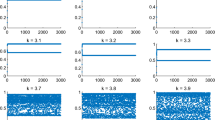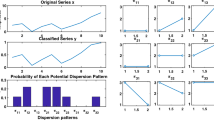Abstract
Many distance measures are used to quantify the relationship between components in complex systems, such as the commonly used Euclidean distance and cos similarity. These distances have a strong connection with the Pearson coefficient. However, the Pearson coefficient sometimes ignores important nonlinear relations. Compared with the Pearson coefficient, the distance correlation coefficient can be a reliable measure of linear and nonlinear relationships. Inspired by this, we propose distance correlation entropy for uncertainty quantification and classifying different states. Unlike other entropy, the distribution of distance correlation is utilized to evaluate complexity. DCE retains the advantages of the previous methods, such as high consistency. The ordinal distance complexity measure is proposed as a supplement to DCE for quantifying information about pattern transitions in time series. Both DCE and ODCM are insensitive to the length of time series. Moreover, distance rank entropy derived from DCE and ODCM can be used to detect abnormal data. Experiments show that DCE and ODCM can distinguish periodic and chaotic behavior as well as different states in nonlinear dynamic systems, such as financial time series, while ODCM and distance rank entropy can be well combined with the uniform manifold approximation and projection method for data classification and visualization. The application in bearing data illustrates that they can be applied to fault diagnosis and get satisfactory results.



















Similar content being viewed by others
References
Yoon, B.J., Qian, X., Dougherty, E.R.: Quantifying the objective cost of uncertainty in complex dynamical systems. IEEE Trans. Signal Process. 61(9), 2256–2266 (2013)
Schlitt, T., Brazma, A.: Current approaches to gene regulatory network modelling. BMC Bioinformatics 8(6), 1–22 (2007)
Zañudo, J.G.T., Yang, G., Albert, R.: Structure-based control of complex networks with nonlinear dynamics. Proc. Natl. Acad. Sci. 114(28), 7234–7239 (2017)
Özkaynak, F.: Brief review on application of nonlinear dynamics in image encryption. Nonlinear Dyn. 92(2), 305–313 (2018)
Laurent, N., Meignen, S.: A novel ridge detector for nonstationary multicomponent signals: development and application to robust mode retrieval. IEEE Trans. Signal Process. 69, 3325–36 (2021)
Jiang, B., Staroswiecki, M., Cocquempot, V.: Fault accommodation for nonlinear dynamic systems. IEEE Trans. Autom. Control 51(9), 1578–1583 (2006)
Valenza, G., Lanata, A., Scilingo, E.P.: The role of nonlinear dynamics in affective valence and arousal recognition. IEEE Trans. Affect. Comput. 3(2), 237–249 (2011)
Guirao, J.L., Luo, A.C.: New trends in nonlinear dynamics and chaoticity. Nonlinear Dyn. 84, 1–2 (2016)
Vannitsem, S.: Predictability of large-scale atmospheric motions: Lyapunov exponents and error dynamics. Chaos Interdiscip. J. Nonlinear Sci. 27(3), 032101 (2017)
Gao, M.C., Yeh, J.W., Liaw, P.K., Zhang, Y., et al.: High-Entropy Alloys. Springer International Publishing, Cham (2016)
Cao, Z., Lin, C.T.: Inherent fuzzy entropy for the improvement of eeg complexity evaluation. IEEE Trans. Fuzzy Syst. 26(2), 1032–1035 (2017)
Yilmaz, A., Unal, G.: Multiscale Higuchi’s fractal dimension method. Nonlinear Dyn. 101(2), 1441–1455 (2020)
Li, Y., Tang, B., Jiao, S.: So-slope entropy coupled with Svmd: A novel adaptive feature extraction method for ship-radiated noise. Ocean Eng. 280, 114677 (2023)
Li, Y., Geng, B., Tang, B.: Simplified coded dispersion entropy: A nonlinear metric for signal analysis. Nonlinear Dyn. 111(10), 9327–9344 (2023)
Mitchell, M.: Complexity: A Guided Tour. Oxford University Press, Oxford (2009)
Bar-Yam, Y.: General Features of Complex Systems Encyclopedia of Life Support Systems (EOLSS). UNESCO EOLSS Publishers, Oxford (2002)
Capra, F., Luisi, P.L.: The Systems View of Life: A Unifying Vision. Cambridge University Press, Cambridge (2014)
Bar-Yam, Y.: About Complex Systems. Addison-Wesley, Reading (1997)
Carter, T.: An Introduction to Information Theory and Entropy. Complex systems summer school, Santa Fe (2007)
Fuchs, A.: Nonlinear Dynamics in Complex Systems. Springer, Cham (2014)
Buchman, T.G.: Nonlinear dynamics, complex systems, and the pathobiology of critical illness. Curr. Opin. Crit. Care 10(5), 378–382 (2004)
Pincus, S.M.: Approximate entropy as a measure of system complexity. Proc. Natl. Acad. Sci. 88(6), 2297–2301 (1991)
Richman, J.S., Moorman, J.R.: Physiological time-series analysis using approximate entropy and sample entropy. Am. J. Physiol. Heart Circ. Physiol. 278(6), 2039 (2000)
Delgado-Bonal, A., Marshak, A.: Approximate entropy and sample entropy: A comprehensive tutorial. Entropy 21(6), 541 (2019)
Zhou, R., Wang, X., Wan, J., Xiong, N.: Edm-fuzzy: An Euclidean distance based multiscale fuzzy entropy technology for diagnosing faults of industrial systems. IEEE Trans. Indus. Inform. 17, 4046 (2020)
Wang, X., Si, S., Li, Y.: Multiscale diversity entropy: A novel dynamical measure for fault diagnosis of rotating machinery. IEEE Trans. Indus. Inform. 17, 5419 (2020)
Székely, G.J., Rizzo, M.L., Bakirov, N.K., et al.: Measuring and testing dependence by correlation of distances. Ann. Stat. 35(6), 2769–2794 (2007)
Székely, G.J., Rizzo, M.L., et al.: Brownian distance covariance. Annal. Appl. Stat. 3(4), 1236–1265 (2009)
Borges, J.B., Ramos, H.S., Mini, R.A., Rosso, O.A., Frery, A.C., Loureiro, A.A.: Learning and distinguishing time series dynamics via ordinal patterns transition graphs. Appl. Math. Comput. 362, 124554 (2019)
Ruan, Y., Donner, R.V., Guan, S., Zou, Y.: Ordinal partition transition network based complexity measures for inferring coupling direction and delay from time series. Chaos Interdiscip. J. Nonlinear Sci. 29(4), 043111 (2019)
Wang, Y., Shi, W., Yeh, C.H.: A novel measure of cardiopulmonary coupling during sleep based on the synchrosqueezing transform algorithm. IEEE J. Biomed. Health Inform. 27(4), 1790–1800 (2023)
Shi, W., Yeh, C.H., Hong, Y.: Cross-frequency transfer entropy characterize coupling of interacting nonlinear oscillators in complex systems. IEEE Trans. Biomed. Eng. 66(2), 521–529 (2018)
McInnes, L., Healy, J., Melville, J.: Umap: Uniform manifold approximation and projection for dimension reduction. arXiv preprint arXiv:1802.03426 (2018)
Berthold, M.R., Höppner, F.: On clustering time series using euclidean distance and pearson correlation. arXiv preprint arXiv:1601.02213 (2016)
Székely, G.J., Rizzo, M.L.: The energy of data. Annual Rev. Stat. Appl. 4, 447–479 (2017)
Edelmann, D., Fokianos, K., Pitsillou, M.: An updated literature review of distance correlation and its applications to time series. Int. Stat. Rev. 87(2), 237–262 (2019)
Daw, C.S., Finney, C.E.A., Tracy, E.R.: A review of symbolic analysis of experimental data. Rev. Sci. Instrum. 74(2), 915–930 (2003)
Bandt, C., Pompe, B.: Permutation entropy: A natural complexity measure for time series. Phys. Rev. Lett. 88(17), 174102 (2002)
Yin, Y., Shang, P.: Multivariate weighted multiscale permutation entropy for complex time series. Nonlinear Dyn. 88, 1707–1722 (2017)
Tarasova, V.V., Tarasov, V.E.: Logistic map with memory from economic model. Chaos, Solitons Fractals 95, 84–91 (2017)
Azami, H., Fernández, A., Escudero, J.: Refined multiscale fuzzy entropy based on standard deviation for biomedical signal analysis. Med. Biol. Eng. Comput. 55, 2037–2052 (2017)
Chen, W., Wang, Z., Xie, H., Yu, W.: Characterization of surface emg signal based on fuzzy entropy. IEEE Trans. Neural Syst. Rehabil. Eng. 15(2), 266–272 (2007)
Costa, M., Goldberger, A.L., Peng, C.K.: Multiscale entropy analysis of biological signals. Phys. Rev. E 71(2), 021906 (2005)
Becht, E., McInnes, L., Healy, J., Dutertre, C.A., Kwok, I.W., Ng, L.G., Ginhoux, F., Newell, E.W.: Dimensionality reduction for visualizing single-cell data using umap. Nat. Biotechnol. 37(1), 38–44 (2019)
Dorrity, M.W., Saunders, L.M., Queitsch, C., Fields, S., Trapnell, C.: Dimensionality reduction by umap to visualize physical and genetic interactions. Nat. Commun. 11(1), 1537 (2020)
Diaz-Papkovich, A., Anderson-Trocmé, L., Gravel, S.: A review of umap in population genetics. J. Hum. Genet. 66(1), 85–91 (2021)
Author information
Authors and Affiliations
Corresponding author
Ethics declarations
Funding
This study is supported by the funds of the Fundamental Research Funds for the Central Universities (2022YJS097), China Academy of Railway Science Cooperation Limited (2019YJ153) and the National Natural Science Foundation of China (62171018).
Data Availability
The stock datasets analyzed during the current study are available, [https://cn.investing.com/] The bearing datasets analyzed during the current study are available, [https://engineering.case.edu/]
Conflict of interest
The authors declare that they have no conflict of interest concerning the publication of this manuscript.
Additional information
Publisher's Note
Springer Nature remains neutral with regard to jurisdictional claims in published maps and institutional affiliations.
The authors declare that they have no conflict of interest concerning the publication of this manuscript.
Rights and permissions
Springer Nature or its licensor (e.g. a society or other partner) holds exclusive rights to this article under a publishing agreement with the author(s) or other rightsholder(s); author self-archiving of the accepted manuscript version of this article is solely governed by the terms of such publishing agreement and applicable law.
About this article
Cite this article
Zhang, B., Shang, P. Distance correlation entropy and ordinal distance complexity measure: efficient tools for complex systems. Nonlinear Dyn 112, 1153–1172 (2024). https://doi.org/10.1007/s11071-023-09080-8
Received:
Accepted:
Published:
Issue Date:
DOI: https://doi.org/10.1007/s11071-023-09080-8




